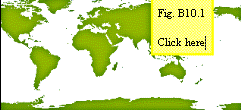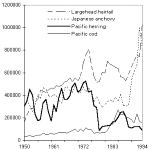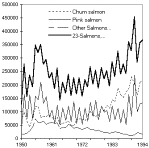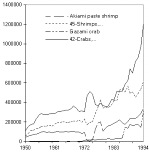FAO Fisheries Circular No. 920 FIRM/C920
Rome, 1997
ISSN 0429-9329
REVIEW OF THE STATE OF WORLD FISHERY RESOURCES: MARINE FISHERIES
by
Marine Resources Service,
Fishery Resources Division,
Fisheries Department,
FAO, Rome, Italy
10. NORTHWEST PACIFIC
FAO Statistical Area 61
INTRODUCTION

This Area (Figure B10.1) encompasses a number of distinct regional ocean subareas, many containing particular extensive areas of highly productive continental shelf (i.e. the northern portion of the South China Sea, the East China Sea, the Yellow Sea, the Sea of Japan and the Sea of Okhotsk). Other subareas have less extensive continental shelf areas but are nevertheless also sites of productive fishery resources (e.g. the western portion of the Bering Sea, the eastern edges of the Ryukyu Islands, Japan, and the Kuril Islands, and the southeastern part of the Kamchatka Peninsula), being characterized by zones of enrichment and concentration of biological processes related to interactions and confluences of swift western ocean boundary currents.
Catches of Alaskan pollock declined by 2.3 million tonnes since 1988 and catches of the Japanese pilchard (sardine) dropped by a massive 4.1 million tonnes; declines of 45% and 76% respectively. The decline of the pollock is thought to be related to excessive fishing pressure, although the evidence suggests at least some environmental component (see Special Topics section: "Global synchrony in fish population variations"). However, it is believed that the sardine collapse must have been primarily due to some sort of natural ecosystem variability.
PROFILE OF CATCHES
| Figure B10.2 | Figure B10.3 |

 Total catches in the Northwest Pacific increased steadily throughout the 1950s
and 1960s as catches of a wide range of species increased (Figure
B10.2). The continued increase through the 1970s and 1980s was primarily
due to the expansion in catches of just two species: Alaskan pollock and Japanese
pilchard (or sardine). Total reported capture fishery landings for 1994 in Area
61 totalled 12 million tonnes, a decline of 4.7 million tonnes or nearly 28
percent from the historical peak landings of 1988. Most of the decline came
from the two populations with the largest potential biomass: the Alaska pollock
and the Japanese pilchard (Figure B10.3). Because
these populations had been so enormous, their collapses have been only minimally
offset by strong rises in landings of many other species, including increases
of about 517 000 t (+170%) of Japanese anchovy, 499 000 t (+94%) of largehead
hairtail, 288 000 t (+140%) of Japanese flying squid and 130 000 t (+51%) of
salmon.
Total catches in the Northwest Pacific increased steadily throughout the 1950s
and 1960s as catches of a wide range of species increased (Figure
B10.2). The continued increase through the 1970s and 1980s was primarily
due to the expansion in catches of just two species: Alaskan pollock and Japanese
pilchard (or sardine). Total reported capture fishery landings for 1994 in Area
61 totalled 12 million tonnes, a decline of 4.7 million tonnes or nearly 28
percent from the historical peak landings of 1988. Most of the decline came
from the two populations with the largest potential biomass: the Alaska pollock
and the Japanese pilchard (Figure B10.3). Because
these populations had been so enormous, their collapses have been only minimally
offset by strong rises in landings of many other species, including increases
of about 517 000 t (+170%) of Japanese anchovy, 499 000 t (+94%) of largehead
hairtail, 288 000 t (+140%) of Japanese flying squid and 130 000 t (+51%) of
salmon.
Figure B10.4
 The strong rise in Japanese anchovy catches that began in 1990 comes after
decades of relatively constant catches at around 350 000 t (Figure
B10.4). 1994 landings of both chub mackerel and Japanese jack mackerel
were the highest in a number of years but were still well below levels of
two to three decades ago. The chub mackerel fishery has, on average, been
around four times larger than that for Japanese jack mackerel. Chub mackerel
landings were about 26% below the averages for the decade of the 1970s while
jack mackerel landings were about 20% below the norm for the decade of the
1960s (Table X).
The strong rise in Japanese anchovy catches that began in 1990 comes after
decades of relatively constant catches at around 350 000 t (Figure
B10.4). 1994 landings of both chub mackerel and Japanese jack mackerel
were the highest in a number of years but were still well below levels of
two to three decades ago. The chub mackerel fishery has, on average, been
around four times larger than that for Japanese jack mackerel. Chub mackerel
landings were about 26% below the averages for the decade of the 1970s while
jack mackerel landings were about 20% below the norm for the decade of the
1960s (Table X).
Pacific herring catches declined rapidly in the early 1970s, rebounded somewhat
in the mid 1980s, and then declined again, with the 1994 catches being only
about one-fourth of the average for the decades of the 1960s and 1970s (Figure
B10.4). The recent increase in largehead hairtail catches began in 1990
and peaked in 1994, with slightly over 1.0 million tonnes landed. Pacific
cod catches have followed the general pattern of the pollock and other North
Pacific groundfish in declining from levels existing in the 1980s (down by
28% from 1988).
| Figure B10.5 | Figure B10.6 |

 The major salmon species in the northwestern Pacific are the chum salmon, which
ordinarily produces the largest catches, and the pink salmon. The chum salmon
landings in 1994 were at an all time high. The pink salmon landings were up
from the previous two years, being about at the level which was the norm for
the 1950s, but substantially down (a 44 percent decrease) from the all-time
peak catches of 1991 (Figure B10.5).
The major salmon species in the northwestern Pacific are the chum salmon, which
ordinarily produces the largest catches, and the pink salmon. The chum salmon
landings in 1994 were at an all time high. The pink salmon landings were up
from the previous two years, being about at the level which was the norm for
the 1950s, but substantially down (a 44 percent decrease) from the all-time
peak catches of 1991 (Figure B10.5).
Catches of various crustacean species have increased greatly since the mid-1970s (Figure B10.6). No single species dominated the catch totals at the ISSCAAP Group level, although the catches of Akiami paste shrimp (of Group 45) and Gazami crabs (of Group 42) have made significant contributions.
Catches of Japanese flying squid (Todarodes pacificus, also called Japanese common squid) have increased in recent years after declining from high levels in the mid 1960s. In 1994 the total amount of squids, cuttlefish and octopuses landed in Area 61 reached an all time high of about 958 000 t (Figure B10.7).RESOURCE STATUS AND MANAGEMENT
Small pelagics
As mentioned above, the largest marine resource variations in the region have concerned the Japanese pilchard (or sardine) population. The sardine fishery off Japan grew rapidly in the 1930s to become the largest single-species fishery existing in the world at that time. Then in the early 1940s the population abruptly collapsed. It remained at extremely depressed levels for nearly three decades and then suddenly exploded in the mid-1970s into a rapid rebuilding phase that led in the 1980s to catches more than twice as large as attained in the peak catches before the earlier collapse (see also in Special Topics section: "Global synchrony in fish population variations"). Now the population, after sustaining major fishery exploitation for a length of time quite similar to that of the earlier fishery, has gone into rapid decline a second time. By 1994 fewer than 1.3 million tonnes were landed (mostly by Japan, but with some catches by China and Republic of Korea) and up to the present time, 1996, the population is continuing to decline and the stock is now at a very low level. Japanese scientists are convinced that the fluctuations in sardine abundance are not the result of fishing but rather are governed by ecosystems changes which may be related to climate variation.
After heavy fishery removals of demersals and larger predatory fishes, Japanese anchovy has taken over as the largest catch in the Yellow Sea, while off Japan anchovy stocks appear to be fluctuating at intermediate levels. Of the 1994 total landings of 821 000 t, 439 000 t were by China, 193 000 t by Republic of Korea, and 188 000 t by Japan. The all-time peak catches were in 1993, when a total of 1.0 million tonnes of Japanese anchovy were landed.
Chub mackerel stocks are considered to be at a low level and there is no sign of recovery; the largest catches are by Japan, but Republic of Korea and China land substantial quantities. On the other hand, the jack mackerel stocks appear to be increasing and are considered to be at an "intermediate level"; the largest catches are by Japan with a minor amount being taken by the Democratic P.R. of Korea. Pacific saury landings have continued to vary quite consistently in a range between about 300 000 and 400 000 t for the past four decades, but the stocks appear to be starting to decline.
Groundfish resources
Currently, the largest fish catches in this Area continue to be of Alaskan pollock, with by far the largest portion being taken by the Russian fishery which landed 1.75 million tonnes in 1994. Other important fisheries on pollock are by Republic of Korea (297 000 t) and China (130 000 t). The overexploited state of this fishery is becoming more and more apparent, and a continuing trend is reported toward an increasing proportion of low value, undifferentiated fish in the landings.
The largest pollock stocks in the northwest Pacific are believed to be those in the Sea of Okhotsk, but the largest recent catches have been in the western Bering Sea where there are reports of large bycatch and discard of small pre-recruit pollock. Other stocks are located off eastern Kamchatka, near the Kuril Islands, off western Japan, and a heavily fished stock in the Japan Sea. All the major stocks are believed to be currently at substantially lower biomass levels than existed in the 1980s and there are forecasts of catch trends continuing downwards for several years into the future. The unregulated fisheries that produced very high catches in the late 1980s and early 1990s in the international waters of the "Doughnut Hole" and "Peanut Hole" have been curtailed.
Pacific cod biomass appears to have increased in the western Bering Sea, but it is unknown whether this is due to local recruitment or its movement from the extensive shelf areas of the stock is increasing (also see discussion of Area 67). Also, it is possible that abundance may be higher in the Sea of Okhotsk than indicated by catches, because of trawling closures designed to protect king crab.
Other Resources
In recent years, the stocks of Japanese flying squid are believed to be fluctuating at intermediate to high levels.
General Concerns
Fishing effort in the region has continued to rise. For example, in the East China Sea the total fishing power of Chinese vessels increased by a factor of about 7.6 between the 1960s and 1990s; catch-per-unit-effort declined over the same period by a factor of 3. In coastal seas such as the East China and Yellow Seas, there has been a shift in catches from large high-valued fish to lower-valued smaller fishes, from demersal and pelagic predator fishes to pelagic plankton-feeding fishes, from mature fish to immature fish. Reduction of fishing effort in some areas is considered an urgent priority.
Environmental problems affecting fisheries in the region include land reclamation, impacts of extensive mariculture, heavy metal pollution and oil spills. There appears to be an increasing frequency of red tides. In the Yellow Sea, virus and bacterial epidemics are causing mortality of cultured shrimp.